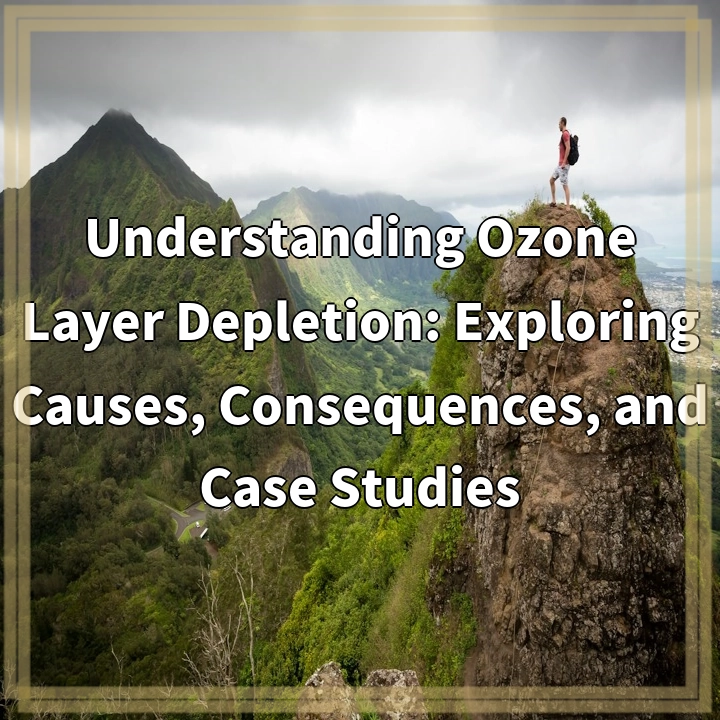
What it is:
Ozone Layer Depletion
Ozone layer depletion refers to the gradual thinning and deterioration of the ozone layer in the Earth’s stratosphere. The ozone layer acts as a shield in the atmosphere, protecting life on Earth from harmful ultraviolet (UV) radiation emitted by the sun. However, human activities have contributed to the depletion of this essential layer, resulting in serious consequences for both human health and the environment.
Real-world problems:
Increased UV Radiation Exposure
One of the most significant real-world problems associated with ozone layer depletion is the increased exposure to UV radiation. As the ozone layer becomes thinner, more UV radiation passes through the atmosphere and reaches the Earth’s surface. Prolonged exposure to UV radiation can have detrimental effects on human health, such as skin cancer, cataracts, immune system suppression, and DNA damage.
Ecological Impact
Ozone layer depletion also poses a threat to various ecosystems and delicate ecological balances. Plants and marine organisms are particularly vulnerable to increased UV radiation. For instance, phytoplankton, which forms the foundation of marine food chains, can be greatly affected by UV radiation, leading to disruption in marine ecosystems and potential decline in fish populations.
Climate Change Implications
The depletion of the ozone layer can have implications for climate change. Certain ozone-depleting substances, such as chlorofluorocarbons (CFCs), not only contribute to ozone depletion but also act as powerful greenhouse gases. These substances trap heat in the atmosphere, contributing to global warming and climate change.
Damage to Materials and Infrastructure
Ultraviolet radiation can cause damage to various materials, including plastics, paints, fabrics, and rubber. Buildings, vehicles, and other infrastructure are not exempt from the harmful effects of increased UV radiation. This can lead to accelerated deterioration and reduced lifespan of materials, posing economic and maintenance challenges.

Solutions to Ozone Layer Depletion:
Phasing Out Ozone-Depleting Substances
To address ozone layer depletion, one of the most crucial steps is the phasing out of ozone-depleting substances (ODS). This includes the strict control and regulation of substances such as chlorofluorocarbons (CFCs), hydrochlorofluorocarbons (HCFCs), and halons, which are known to significantly contribute to ozone depletion. International agreements, such as the Montreal Protocol, have been instrumental in reducing the production and consumption of these harmful substances.
Promoting Alternative Technologies
Encouraging the use of alternative technologies and substances that are ozone-friendly is another solution to address ozone layer depletion. The development and adoption of ozone-friendly alternatives in industries such as refrigeration, air conditioning, and aerosol production have greatly contributed to reducing the reliance on ozone-depleting substances. This includes the use of hydrofluorocarbons (HFCs) as a substitute for CFCs and HCFCs.
Educating and Raising Awareness
Raising public awareness and educating individuals about the importance of the ozone layer and its depletion is crucial in promoting sustainable practices. This includes educating the public about the harmful effects of excessive UV radiation, promoting the use of protective measures such as sunscreen and UV-blocking clothing, and encouraging responsible behavior in regards to ODS use and disposal.
Supporting Scientific Research and Monitoring
Continued scientific research and monitoring of the ozone layer are necessary to understand the progress of ozone layer recovery and to identify any emerging threats. Support for research institutions, funding for monitoring systems, and global collaboration are essential to track the effectiveness of measures taken to address ozone layer depletion.
International Cooperation and Commitment
International cooperation and commitment play a vital role in addressing ozone layer depletion. Collaborative efforts between governments, industry stakeholders, scientific communities, and the public are required to ensure the implementation and compliance with regulations and initiatives targeting the reduction of ozone-depleting substances. Regular meetings and conferences provide a platform for sharing knowledge, exchanging best practices, and strengthening global resolve to protect the ozone layer.















